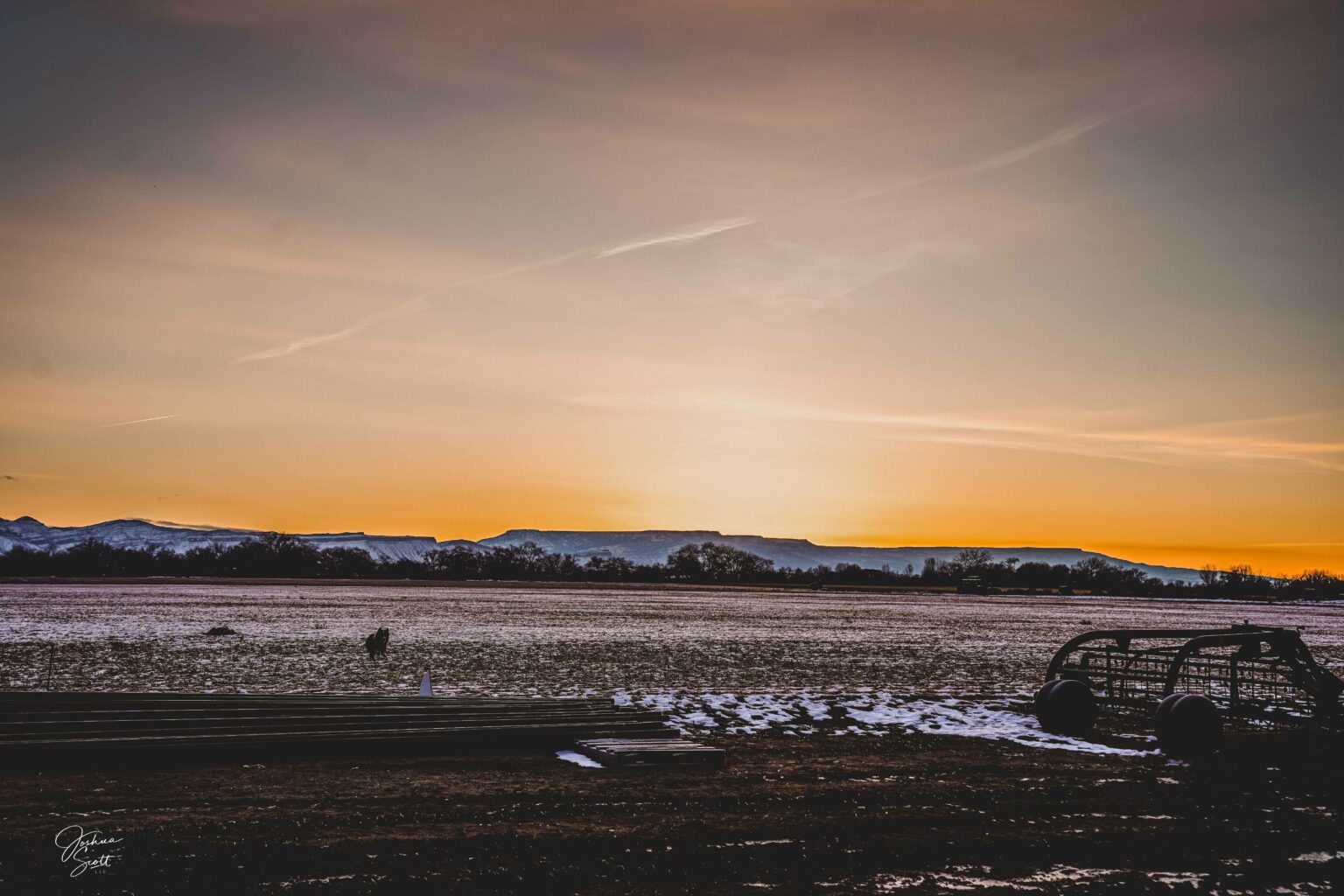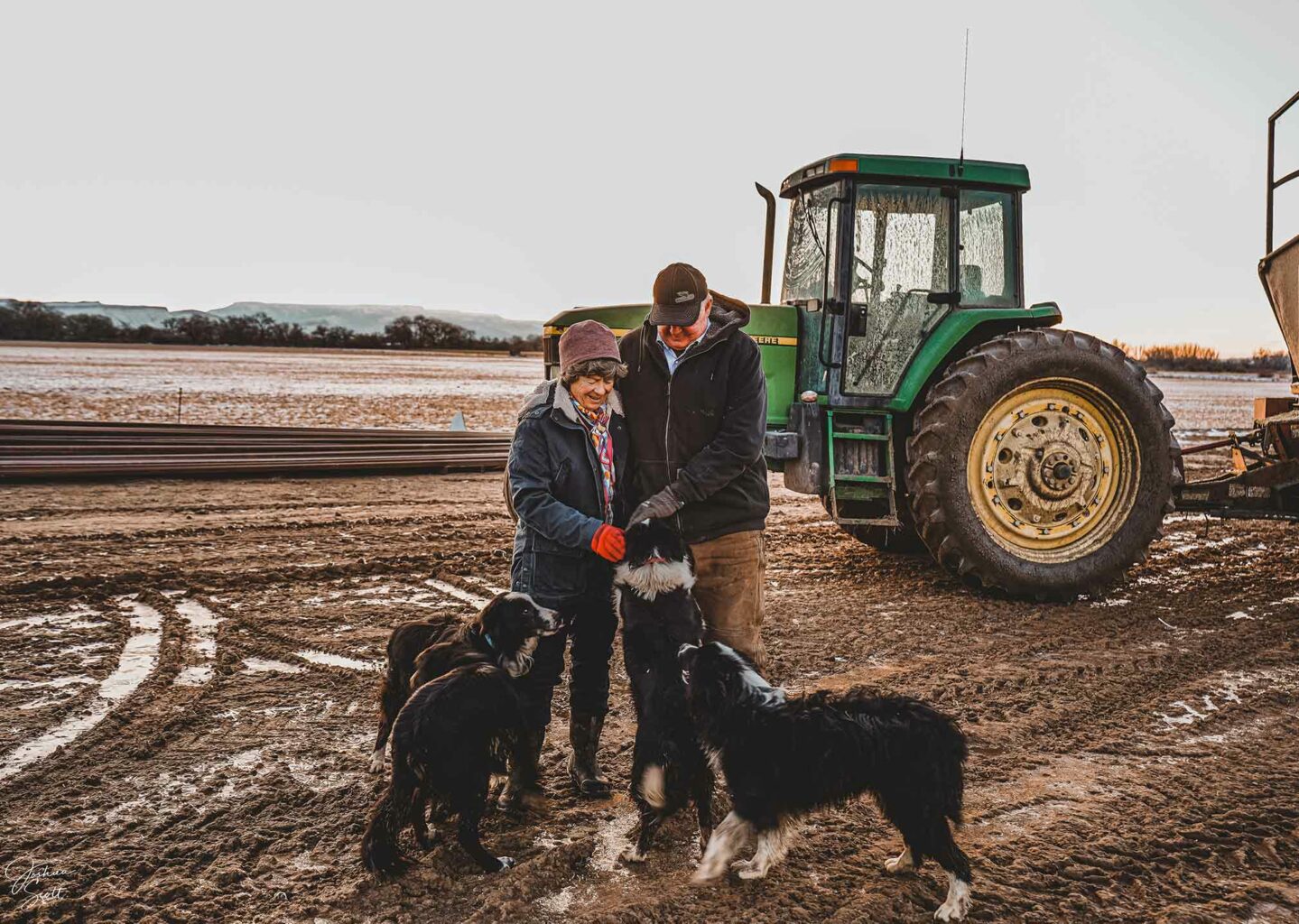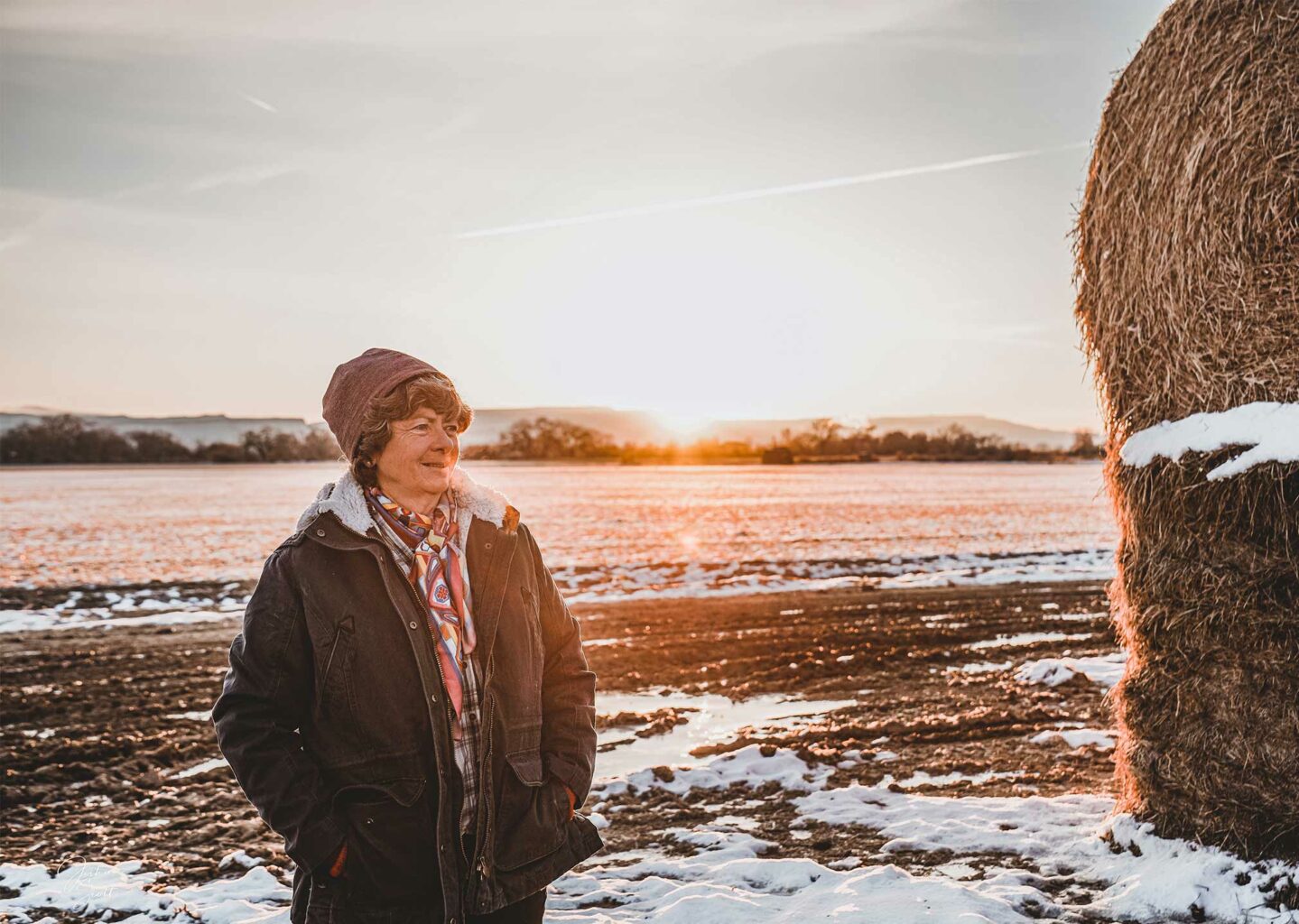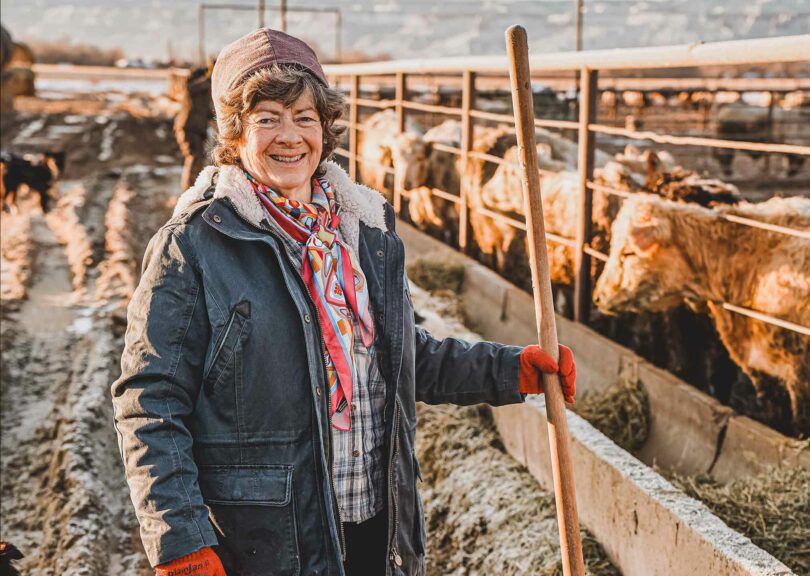By Sharon Sullivan,
Photography by Joshua Scott LLC –
On a crisp, blue-sky November day on a Colorado cattle ranch on the Western Slope, Janie VanWinkle, her husband Howard and their son Dean ride horseback across crunchy snow as they bring their cows down from the Uncompahgre Plateau to lower-elevation winter grazing lands in Unaweep Canyon. Dean’s wife and baby daughter meet the family with a vehicle at the bottom of the canyon.
“I was riding a good horse, enjoying the conversation and felt proud of how good the young cows in the herd looked,” Janie VanWinkle recalled, reflecting on that day. “We came off a trail that my family has used for the past 70 years doing the same thing.”

Early morning chores on VanWinkle Ranch are set against a beautiful backdrop of sunrise over the majestic Book Cliffs along the Grand Valley
Herd dogs help gather the cattle that have dispersed across the Uncompahgre, as well as on Grand Mesa — the flat-topped mountain east of the Grand Valley. The annual fall roundup, which begins in October, involves a dozen riders representing two families, both of which have permits to graze cattle on federal public lands. “It takes a while to gather [the cows] up,” Janie said. “We sort them out. Sometimes it’s snowing; sometimes it’s very windy.”
Janie grew up in Unaweep Canyon, where her great-grandfather had purchased a ranch in the late 1880s. She remembers being carried on horseback by her mother, Martha Hendrickson, before she began riding a Shetland pony on her own at age 4. She recalls crossing the Dolores River on horseback to help manage cows on the other side (although she never learned to swim).
As a child, Janie raised and showed cows at the Mesa County and Colorado State fairs as well as the National Western Stock Show in Denver. “I bought my first cow from grandpa when I was 8 years old,” Janie said. Howard grew up in nearby Grand Junction, where he worked on his parents’ small farm after school and on weekends. The two met in 4-H when she was 12 and he was 10.
Nearly a decade later they were married and ready to start their own Colorado cattle ranch in Fruita with Janie’s 20 cows and Howard’s 20 sheep. “We knew this is what we wanted to do since we were 18,” Janie said. Over the years they’ve grown their operation to 500–600 cows, a number that varies from year to year depending on the drought. (They no longer raise sheep, having sold them in the early 2000s).
Even though Janie and Howard are both fourth-generation ranchers, building their own ranch hasn’t been easy — neither of them inherited any land or livestock. Instead, they grew their Colorado cattle ranch through “grit and determination,” as Janie likes to say. For 35 years, they each had jobs in Grand Junction while also tending cows at home. Janie worked retail, including a stint as store manager at Barnes & Noble Booksellers. She later opened a pizza restaurant that she ran for 10 years before selling it in 2015. Howard owned an automobile repair shop that he sold in 2010.
Janie remembers going on just one vacation: to Disneyland in 2009. “We’d go places, but it always had to do with a cow, a horse, a saddle, a tractor or a bull,” she said. Now, at ages 62 and 60, the couple focuses on ranching full time.
“WE LOVE THEIR HAMBURGER”
A border collie bounds across their property located at the end of a gravel road where the Book Cliffs loom large to the north of their 1930s-era farmhouse. To the south, the red cliffs of Colorado National Monument can be seen in the distance. Bales of hay are stacked neatly near corrals where 100 or so young cows hang out until spring. “You can tell they’re content; they’re chewing their cud,” Janie said, while showing a visitor around the ranch.
One corral holds purebred Charolais bull calves that belong to their son who will eventually sell the bulls as breeding stock. When Dean left for college five years ago, he knew he needed to add an enterprise to the ranch to remain part of the family business. The Colorado cattle ranch supports his parents, but it needed to expand in order to sustain a second family. “We all work together on the ranch,” Janie said. “Dean’s bulls will be sold to people like us. We buy 10–15 bulls a year to preserve a fresh genetic pool. We keep bulls for five years, and then they go into the food supply chain.”
Janie and Howard are commercial cow-calf producers; they sell 6- to 8-month-old calves via video auction that takes place in July. In November, buyers send trucks to pick up the calves and bring them to Colorado feedlots in Montrose, Gilcrest and Briggsdale.
In 2018, the VanWinkles also began selling their beef directly to local consumers through word-of-mouth and via Facebook. The calves are processed in Fruita and sold as freezer beef either whole or by the half. Customers can request ground beef or custom cuts of 3/4- or 1 1/2-inch-thick steaks, which come two to six per package. The meat hangs for two or three weeks to increase flavor and tenderness, Janie explained.
Customers include Grand Valley residents Margie and Jim Beougher who camp and hunt on the Uncompahgre and Grand Mesa. Over the years, the couple would often see and wave to Howard and Janie tending their cattle. During the height of the COVID-19 pandemic, Margie found that ground beef was harder to find — and more expensive — at the grocery store due to supply-chain issues. That’s when she decided to try the VanWinkle’s beef after seeing an ad on Facebook.
“It tasted so good. We’ve bought it for three years now,” Margie said. “We’re on the Uncompahgre and Grand Mesa, where they graze their cattle, so we knew where the beef was coming from.” Margie said she purchases 20-pound allotments whenever she starts to get low on beef. “We really like Janie and Howard, and we love their hamburger,” Margie said. “They’re good stewards to their cattle and the land where they range. We’ve seen them on the mountain for years.”
The VanWinkle’s market for selling beef locally grew quickly. In early 2020 the family set a goal to sell 200 pounds of beef per month. By mid-March they had exhausted the supply at their Colorado cattle ranch. They didn’t have ground beef available again until July, which also sold out immediately, Janie said. While she appreciates the local market and consumers’ interest in locally-raised food, Janie is also passionate about their beef being part of the national food supply chain, which she says is important for feeding the masses.
Additionally, the VanWinkles sell 40,000 pounds of beef at a discounted rate to Food Bank of the Rockies. The food bank distributes the meat to food pantries across Colorado and Wyoming. “That partnership is exciting,” Janie said. “We’re providing high-quality protein to people who need it the most.”
LIFE ON A COLORADO CATTLE RANCH
When calving season begins in February, Janie and Howard take turns every four hours checking on first-time mamas, including throughout the night. Four to 10 calves are born each day during the first 20 days of the calving season, which lasts for three months. Dean, who lives with his wife and child in Whitewater, checks on the older, more experienced pregnant cows who graze on city-owned property that the family leases near Whitewater. The VanWinkles lease about 12,000 acres from the city, which owns the property for its water rights.
Grand Junction’s water services manager Mark Ritterbush is pleased with the partnership. He said the VanWinkles are good stewards of the land and are careful to not overgraze the property. Plus, the city benefits from leasing the land because it puts Grand Junction’s water rights to “beneficial use,” which Ritterbush said helps the city maintain those rights. Grand Junction is one of the larger landowners in Mesa County and has leased property to the VanWinkles for 15 years, he noted.
By June, it’s time to gather cattle from the Fruita ranch and from their lower winter grazing lands and return to the cooler, higher elevations on the Uncompahgre (8,500 feet) and Grand Mesa — leased public lands that include Bureau of Land Management and U.S. Forest Service property. “We use a rotational grazing system so plants can grow back after the cows have grazed an area,” Janie said. The VanWinkles also grow hay to supplement their winter feed while the natural forage lies dormant. Howard’s 87-year-old father used the swather to cut this year’s hay.

Janie and Howard VanWinkle have grown their operation outside Fruita to 500-600 cows.
For the next few months, three or four days each week, after the morning chores of feeding cats and dogs, making phone calls, doing paperwork and raking and baling hay, Janie and Howard trailer their horses and head to Grand Mesa or the Uncompahgre to check on their cows. They return home 12 hours later; that’s when Janie cooks supper, which always includes beef — and dessert. “I’ve never cooked a chicken and I’m proud of that,” Janie said, half-joking. She invites a widower neighbor to join them for dinner three or four times each week. “I text him ‘supper will be at 9:30 or 10 o’clock,’” Janie said.
PUBLIC SERVICE
Janie’s rancher grandfather Jerome Craig found time to be active in civic matters, and she also feels called to serve her community and advocate for a way of life most people have never experienced. “One thing that concerns me in Colorado is the urban-rural divide,” Janie said. “I saw an opportunity to connect the two, especially as many folks are moving into rural Colorado from urban areas.”
Janie served on the Grand Junction Chamber Board of Directors from 2015–2021. For the past 10 years she’s volunteered on the Colorado Cattlemen’s Association board, serving as president of the board from 2020–2021. In August 2017, Janie was elected to the Grand Valley Power Board of Directors and currently serves as vice president of the board for the local electric cooperative.

Janie VanWinkle, a fourth-generation rancher, bought her first cow at age 8.
“The similarities between food production — which I am so passionate about — and power has been very enlightening for me,” Janie said. “Advocating for all members of rural electric cooperatives is very important to me.”
Electric cooperatives were formed 83 years ago by farmers and ranchers for the purpose of delivering electricity to rural areas not served by investor-owned utilities. Rural areas were less densely populated, thus unprofitable for the utility companies, Janie said. Grand Valley Power supplies power to areas in Mesa County that Xcel Energy doesn’t serve.
“Having lived at some of the cow camps on the remote ranches while growing up where there was no power, it makes me appreciate what those rural farmers and ranchers did when they found a way to bring power to areas out in the country in a cooperative way,” Janie said. “It changed life for many people.”
Janie, an outspoken advocate for ranchers and beef production, has often been interviewed by local and national media, including The Washington Post and Time, where she’s been asked to comment on such issues as Colorado’s long-term drought and its effects on ag producers.
To help raise awareness of issues affecting the ag industry, Janie works tirelessly to motivate ranchers and farmers to get involved in matters concerning agriculture.
“We want consumers to understand the issues,” Janie said. “I post every day on Facebook what we do on the ranch. There are sick calves and cold nasty days, as well as blue skies and beautiful sunsets. Many people are three generations removed from growing their own food. It’s important for us to tell our stories.”
For more information about VanWinkle Ranch, visit VanWinkleRanch.com or follow along on Facebook at facebook.com/VanWinkleRanch and facebook.com/JanieVanWinkleSeeJaneRanch.
Sharon Sullivan is based in Grand Junction and enjoys telling the stories of people on the Western Slope.

